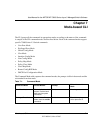
User Manual for the NETGEAR 7300S Series Layer 3 Managed Switch Software
7-6 Mode-based CLI
202-10088-01, March 2005
Flow of Operation
This section captures the flow of operation for the CLI:
1. The operator logs into the CLI session and enters the User Exec mode. In the User Exec mode
the $(exec)> prompt is displayed on the screen.
The parsing process is initiated whenever the operator types a command and presses <ENTER>.
The command tree is searched for the command of interest. If the command is not found, the
output message indicates where the offending entry begins. For instance, command node A has the
command
"show arp brief" but the operator attempts to execute the command "show arpp
brief"
then the output message would be $(exec)> show arpp brief^. $%Invalid input detected at '^'
marker.
If the operator has given an invalid input parameter in the command, then the message
conveys to the operator an invalid input was detected. The layout of the output is depicted below:
FIGURE 2. Syntax Error Message
After all the mandatory parameters are entered, any additional parameters entered are treated as
optional parameters. If any of the parameters are not recognized a syntax error message will be
displayed.
2. After the command is successfully parsed and validated, the control of execution goes to the
corresponding CLI callback function.
3. For mandatory parameters, the command tree extends till the mandatory parameters make the
leaf of the branch. The callback function is only invoked when all the mandatory parameters
are provided. For optional parameters, the command tree extends till the mandatory
parameters and the optional parameters make the leaf of the branch. However, the call back
function is associated with the node where the mandatory parameters are fetched. The call
back function then takes care of the optional parameters.
4. Once the control has reached the callback function, the callback function has complete
information about the parameters entered by the operator.
(exec) #show arpp brief
^
%Invalid input detected at ‘^’ marker.


















